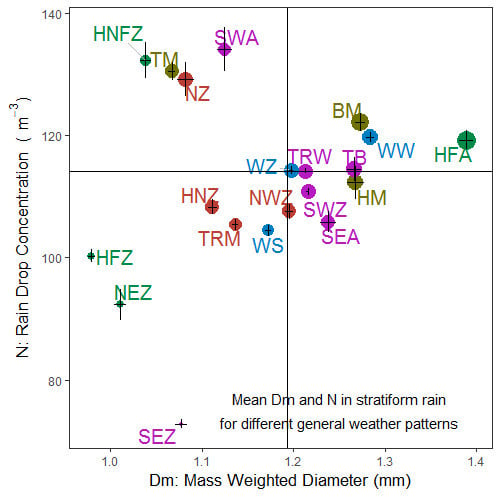Rain Microstructure Parameters Vary with Large-Scale Weather Conditions in Lausanne, Switzerland
Abstract
:1. Introduction
- (I)
- Does the rain microstructure differ between general weather patterns in both convective and stratiform rain types?
- (II)
- How much does this influence the radar reflectivity and rain rate, i.e., the Z–R relation?
2. Materials and Methods
2.1. Data Sources
2.2. Measurement Device
2.3. Separation of Convective and Stratiform Rain Intervals
2.4. Data Filtering
- Intervals characterized by high wind speed were completely removed from the dataset. These intervals were indicated by the existence of large drops D > 5 mm with a low falling speed V < 1 m·s−1.
- All particles larger than 8 mm in diameter were not considered to be rain and filtered out.
- Particles with velocities higher than 160% of the associated terminal velocity for the diameter class center as given by Atlas et al. [65] were filtered out (margin fallers).
- Small particles (D < 2 mm) with low velocity (<40% of the terminal velocity) were filtered out (splashing).
- Large particles (D > 5 mm) with low velocity (<40% of the terminal velocity) were filtered out (hail).
- For particles with a diameter between 2 mm and 5 mm, a fall velocity threshold was established based on the average terminal velocity of rain and graupel for each diameter bin. Then, all particles with a fall velocity below this threshold were filtered out.
- Intervals associated with a damaged laser signal as reported in the raw output of the disdrometers;
- Intervals associated with snow, hail, frozen rain, or mixed precipitation as reported by the disdrometer;
- Intervals with rain intensities lower than 0.1 mm·h−1;
- Intervals where three or less diameter bins recorded rain drops to ensure the existence of a drop size distribution; and
- Intervals of rain that occurred in the transitional GWL U.
2.5. Assessing the Performance of the Z–R Relation
2.6. Statistical Tests
3. Results
3.1. Variation in Rain Duration, Amount and Rates with Rain Type and GWL
3.2. Rain Microstructure
3.2.1. Drop Size Distribution (DSD)
3.2.2. Rain Parameters R, Dm and N
3.3. The Z–R Relation
4. Discussion
4.1. Weather Type Classification
4.2. Rain Type Classification
4.3. Rain Microstructure
4.4. The Z–R Relation
5. Conclusions
Supplementary Materials
Author Contributions
Acknowledgments
Conflicts of Interest
Appendix A
- Rain intensity (R) (mm·h−1) [16]: Detected number of drops that fall in diameter range i and velocity range j.(s): Temporal resolution = 60 s in this case.(m2): Corrected detection area [60]: .(mm): Mean diameter of drops that fall in diameter range i.
- The reflectivity is usually expressed in another unit [dBZ]:
- Total drop concentration (N) (m−3), i.e., the total number of drops per m3 [16]:(mm): Width of a diameter range i.
- Mass weighted diameter (Dm) (mm) [61]:
References
- Hazenberg, P.; Yu, N.; Boudevillain, B.; Delrieu, G.; Uijlenhoet, R. Scaling of raindrop size distributions and classification of radar reflectivity–rain rate relations in intense Mediterranean precipitation. J. Hydrol. 2011, 402, 179–192. [Google Scholar] [CrossRef]
- Lal, R. Soil Erosion Research Methods, 2nd ed.; Soil and Water Conservation Society; St. Lucie Press: Ankeny, IA, USA, 1994. [Google Scholar]
- Angulo-Martínez, M.; Barros, A.P. Measurement uncertainty in rainfall kinetic energy and intensity relationships for soil erosion studies: An evaluation using PARSIVEL disdrometers in the Southern Appalachian Mountains. Geomorphology 2015, 228, 28–40. [Google Scholar] [CrossRef]
- Murphy, L.U.; Cochrane, T.A.; O’Sullivan, A. Build-up and wash-off dynamics of atmospherically derived Cu, Pb, Zn and TSS in stormwater runoff as a function of meteorological characteristics. Sci. Total Environ. 2015, 508, 206–213. [Google Scholar] [CrossRef] [PubMed]
- Moupfouma, F.; Martin, L. Modelling of the rainfall rate cumulative distribution for the design of satellite and terrestrial communication systems. Int. J. Satell. Commun. Netw. 1995, 13, 105–115. [Google Scholar] [CrossRef]
- Shkarofsky, I. Dependence of rain attenuation and cross-polarization on drop size distribution. IEEE Trans. Antennas Propag. 1979, 27, 538–542. [Google Scholar] [CrossRef]
- Thurai, M.; Gatlin, P.N.; Bringi, V.N. Separating stratiform and convective rain types based on the drop size distribution characteristics using 2D video disdrometer data. Atmos. Res. 2016, 169, 416–423. [Google Scholar] [CrossRef]
- Caracciolo, C.; Porcù, F.; Prodi, F. Precipitation classification at mid-latitudes in terms of drop size distribution parameters. Adv. Geosci. 2008, 16, 11–17. [Google Scholar] [CrossRef]
- Tapiador, F.J.; Navarro, A.; Moreno, R.; Jiménez-Alcázar, A.; Marcos, C.; Tokay, A.; Durán, L.; Bodoque, J.M.; Martín, R.; Petersen, W. On the Optimal Measuring Area for Pointwise Rainfall Estimation: A Dedicated Experiment with 14 Laser Disdrometers. J. Hydrometeorol. 2017, 18, 753–760. [Google Scholar] [CrossRef]
- Jaffrain, J.; Studzinski, A.; Berne, A. A network of disdrometers to quantify the small-scale variability of the raindrop size distribution. Water Resour. Res. 2011, 47, W00H06. [Google Scholar] [CrossRef]
- Jaffrain, J.; Berne, A. Quantification of the Small-Scale Spatial Structure of the Raindrop Size Distribution from a Network of Disdrometers. J. Appl. Meteorol. Climatol. 2012, 51, 941–953. [Google Scholar] [CrossRef]
- Jameson, A.R.; Larsen, M.L.; Kostinski, A.B. Disdrometer Network Observations of Finescale Spatial–Temporal Clustering in Rain. J. Atmos. Sci. 2015, 72, 1648–1666. [Google Scholar] [CrossRef]
- Das, S.; Maitra, A. Characterization of tropical precipitation using drop size distribution and rain rate-radar reflectivity relation. Theor. Appl. Climatol. 2018, 132, 275–286. [Google Scholar] [CrossRef]
- Gatlin, P.N.; Thurai, M.; Bringi, V.N.; Petersen, W.; Wolff, D.; Tokay, A.; Carey, L.; Wingo, M. Searching for Large Raindrops: A Global Summary of Two-Dimensional Video Disdrometer Observations. J. Appl. Meteorol. Climatol. 2015, 54, 1069–1089. [Google Scholar] [CrossRef]
- Bringi, V.N.; Chandrasekar, V.; Hubbert, J.; Gorgucci, E.; Randeu, W.L.; Schoenhuber, M. Raindrop Size Distribution in Different Climatic Regimes from Disdrometer and Dual-Polarized Radar Analysis. J. Atmos. Sci. 2003, 60, 354–365. [Google Scholar] [CrossRef]
- Chen, B.; Wang, J.; Gong, D. Raindrop Size Distribution in a Midlatitude Continental Squall Line Measured by Thies Optical Disdrometers over East China. J. Appl. Meteorol. Climatol. 2016, 55, 621–634. [Google Scholar] [CrossRef]
- Maki, M.; Keenan, T.D.; Sasaki, Y.; Nakamura, K. Characteristics of the Raindrop Size Distribution in Tropical Continental Squall Lines Observed in Darwin, Australia. J. Appl. Meteorol. 2001, 40, 1393–1412. [Google Scholar] [CrossRef]
- Islam, T.; Rico-Ramirez, M.A.; Thurai, M.; Han, D. Characteristics of raindrop spectra as normalized gamma distribution from a Joss–Waldvogel disdrometer. Atmos. Res. 2012, 108, 57–73. [Google Scholar] [CrossRef]
- Hu, Z.; Srivastava, R.C. Evolution of Raindrop Size Distribution by Coalescence, Breakup, and Evaporation: Theory and Observations. J. Atmos. Sci. 1995, 52, 1761–1783. [Google Scholar] [CrossRef]
- Villermaux, E.; Bossa, B. Single-drop fragmentation determines size distribution of raindrops. Nat. Phys. 2009, 5, 697–702. [Google Scholar] [CrossRef]
- Kumjian, M.R.; Ryzhkov, A.V. The Impact of Evaporation on Polarimetric Characteristics of Rain: Theoretical Model and Practical Implications. J. Appl. Meteorol. Climatol. 2010, 49, 1247–1267. [Google Scholar] [CrossRef]
- Rosenfeld, D.; Mintz, Y. Evaporation of Rain Falling from Convective Clouds as Derived from Radar Measurements. J. Appl. Meteorol. 1988, 27, 209–215. [Google Scholar] [CrossRef]
- Kumjian, M.R.; Ryzhkov, A.V. The Impact of Size Sorting on the Polarimetric Radar Variables. J. Atmos. Sci. 2012, 69, 2042–2060. [Google Scholar] [CrossRef]
- Munchak, S.J.; Kummerow, C.D.; Elsaesser, G. Relationships between the Raindrop Size Distribution and Properties of the Environment and Clouds Inferred from TRMM. J. Clim. 2012, 25, 2963–2978. [Google Scholar] [CrossRef]
- Berg, W.; L’Ecuyer, T.; van den Heever, S. Evidence for the impact of aerosols on the onset and microphysical properties of rainfall from a combination of satellite observations and cloud-resolving model simulations. J. Geophys. Res. 2008, 113. [Google Scholar] [CrossRef]
- Givati, A.; Rosenfeld, D. Separation between Cloud-Seeding and Air-Pollution Effects. J. Appl. Meteorol. 2005, 44, 1298–1314. [Google Scholar] [CrossRef]
- Harikumar, R. Orographic effect on tropical rain physics in the Asian monsoon region. Atmos. Sci. Lett. 2016, 17, 556–563. [Google Scholar] [CrossRef]
- Zwiebel, J.; van Baelen, J.; Anquetin, S.; Pointin, Y.; Boudevillain, B. Impacts of orography and rain intensity on rainfall structure. The case of the HyMeX IOP7a event. Q. J. R. Meteorol. Soc. 2016, 142, 310–319. [Google Scholar] [CrossRef]
- Hachani, S.; Boudevillain, B.; Delrieu, G.; Bargaoui, Z. Drop Size Distribution Climatology in Cévennes-Vivarais Region, France. Atmosphere 2017, 8. [Google Scholar] [CrossRef]
- Wen, J.; Zhao, K.; Huang, H.; Zhou, B.; Yang, Z.; Chen, G.; Wang, M.; Wen, L.; Dai, H.; Xu, L.; et al. Evolution of microphysical structure of a subtropical squall line observed by a polarimetric radar and a disdrometer during OPACC in Eastern China. J. Geophys. Res. 2017, 122, 8033–8050. [Google Scholar] [CrossRef]
- Steiner, M.; Smith, J.A. Convective versus stratiform rainfall: An ice-microphysical and kinematic conceptual model. Atmos. Res. 1998, 47-48, 317–326. [Google Scholar] [CrossRef]
- Rosenfeld, D.; Ulbrich, C.W. Cloud Microphysical Properties, Processes, and Rainfall Estimation Opportunities. In Radar and Atmospheric Science: A Collection of Essays in Honor of David Atlas; American Meteorological Society: Boston, MA, USA, 2003. [Google Scholar]
- Campos, E.F.; Zawadzki, I.; Petitdidier, M.; Fernández, W. Measurement of raindrop size distributions in tropical rain at Costa Rica. J. Hydrol. 2006, 328, 98–109. [Google Scholar] [CrossRef]
- Penide, G.; Kumar, V.V.; Protat, A.; May, P.T. Statistics of Drop Size Distribution Parameters and Rain Rates for Stratiform and Convective Precipitation during the North Australian Wet Season. Mon. Weather Rev. 2013, 141, 3222–3237. [Google Scholar] [CrossRef]
- Huth, R.; Beck, C.; Philipp, A.; Demuzere, M.; Ustrnul, Z.; Cahynová, M.; Kyselý, J.; Tveito, O.E. Classifications of atmospheric circulation patterns: Recent advances and applications. Ann. N. Y. Acad. Sci. 2008, 1146, 105–152. [Google Scholar] [CrossRef] [PubMed]
- Ramos, A.M.; Barriopedro, D.; Dutra, E. Circulation weather types as a tool in atmospheric, climate, and environmental research. Front. Environ. Sci. 2015, 3. [Google Scholar] [CrossRef]
- Brdossy, A.; Caspary, H.J. Detection of climate change in Europe by analyzing European atmospheric circulation patterns from 1881 to 1989. Theor. Appl. Climatol. 1990, 42, 155–167. [Google Scholar] [CrossRef]
- Baur, F.; Hess, P.; Nagel, H. Kalender der Grosswetterlagen Europas 1881–1939. Bad Homburg 1944, 35. [Google Scholar]
- Gerstengarbe, F.-W.; Werner, P.C.; Busold, W.; Hess, P.; Brezowsky, H. Katalog der Grosswetterlagen Europas nach Paul Hess und Helmuth Brezowski 1881–1992; 4., vollständig neu bearbeitete Aufl.; Selbstverlag des Deutschen Wetterdienstes: Offenbach am Main, Germany, 1993; p. 244. Available online: https://www.dwd.de/DE/leistungen/pbfb_verlag_berichte/pdf_einzelbaende/113_pdf.pdf?__blob=publicationFile&v=3 (accessed on 23 May 2018).
- BUISHAND, T.A.; BRANDSMA, T. Comparison of circulation classification schemes for predicting temperature and precipitation in the Netherlands. Int. J. Climatol. 1997, 17, 875–889. [Google Scholar] [CrossRef]
- Cony, M.; Martín, L.; Hernándes, E.; Del Teso, T. Synoptic Patterns That Contribute to Extremely Hot Days in Europe. Available online: http://www.scielo.org.mx/scielo.php?script=sci_arttext&pid=S0187-62362010000400001 (accessed on 9 April 2018).
- Steirou, E.; Gerlitz, L.; Apel, H.; Merz, B. Links between large-scale circulation patterns and streamflow in Central Europe: A review. J. Hydrol. 2017, 549, 484–500. [Google Scholar] [CrossRef]
- Jacobeit, J.; Glaser, R.; Luterbacher, J.; Wanner, H. Links between flood events in central Europe since AD 1500 and large-scale atmospheric circulation modes. Geophys. Res. Lett. 2003, 30. [Google Scholar] [CrossRef]
- Petrow, T.; Merz, B.; Lindenschmidt, K.-E.; Thieken, A.H. Aspects of seasonality and flood generating circulation patterns in a mountainous catchment in south-eastern Germany. Hydrol. Earth Syst. Sci. 2007, 11, 1455–1468. [Google Scholar] [CrossRef]
- Wastl, C.; Schunk, C.; Lüpke, M.; Cocca, G.; Conedera, M.; Valese, E.; Menzel, A. Large-scale weather types, forest fire danger, and wildfire occurrence in the Alps. Agric. For. Meteorol. 2013, 168, 15–25. [Google Scholar] [CrossRef]
- Nikolopoulos, E.I.; Borga, M.; Marra, F.; Crema, S.; Marchi, L. Debris flows in the eastern Italian Alps: Seasonality and atmospheric circulation patterns. Nat. Hazards Earth Syst. Sci. 2015, 15, 647–656. [Google Scholar] [CrossRef]
- Ustrnul, Z.; Czekierda, D. Circulation background of the atmospheric precipitation in Central Europe (based on the Polish example). Meteorol. Z. 2001, 10, 103–111. [Google Scholar] [CrossRef]
- Ducić, V.; Luković, J.; Burić, D.; Stanojević, G.; Mustafić, S. Precipitation extremes in the wettest Mediterranean region (Krivošije) and associated atmospheric circulation types. Nat. Hazards Earth Syst. Sci. 2012, 12, 687–697. [Google Scholar] [CrossRef]
- Nowosad, J.; Stach, A. Relation between extensive extreme precipitation in Poland and atmospheric circulation. Quaest. Geogr. 2014, 33, 115–129. [Google Scholar] [CrossRef]
- Planchon, O.; Quénol, H.; Dupont, N.; Corgne, S. Application of the Hess-Brezowsky classification to the identification of weather patterns causing heavy winter rainfall in Brittany (France). Nat. Hazards Earth Syst. Sci. 2009, 9, 1161–1173. [Google Scholar] [CrossRef]
- Hoy, A.; Schucknecht, A.; Sepp, M.; Matschullat, J. Large-scale synoptic types and their impact on European precipitation. Theor. Appl. Climatol. 2014, 116, 19–35. [Google Scholar] [CrossRef]
- Blenkinsop, S.; Chan, S.C.; Kendon, E.J.; Roberts, N.M.; Fowler, H.J. Temperature influences on intense UK hourly precipitation and dependency on large-scale circulation. Environ. Res. Lett. 2015, 10. [Google Scholar] [CrossRef]
- Fernandez-Raga, M.; Castro, A.; Marcos, E.; Palencia, C.; Fraile, R. Weather types and rainfall microstructure in Leon, Spain. Int. J. Climatol. 2017, 37, 1834–1842. [Google Scholar] [CrossRef]
- Berne, A.; Jaffrain, J. GPM Ground Validation NASA EPFL-LTE Parsivel DSD Data Lausanne, Switzerland; NASA Global Hydrology Resource Center DAAC: Huntsville, AL, USA, 2016.
- Knittel, J. Großwetterlage: Januar bis Dezember 2008. Available online: https://www.dwd.de/DE/leistungen/grosswetterlage/2008/gwl_zusammenfassung.pdf?__blob=publicationFile&v=3 (accessed on 3 April 2018).
- Knittel, J. Großwetterlage: Januar bis Dezember 2009. Available online: https://www.dwd.de/DE/leistungen/grosswetterlage/2009/gwl_zusammenfassung.pdf?__blob=publicationFile&v=3 (accessed on 3 April 2018).
- Knittel, J. Großwetterlage: Januar bis Dezember 2010. Available online: https://www.dwd.de/DE/leistungen/grosswetterlage/2010/gwl_zusammenfassung.pdf?__blob=publicationFile&v=3 (accessed on 3 April 2018).
- OTT MESSTECHNIK GmbH & Co. K. Present Weather Sensor Parsivel: Operating Instructions. Available online: https://www.esrl.noaa.gov/psd/data/obs/instruments/OpticalDisdrometer.pdf (accessed on 29 March 2018).
- Löffler-Mang, M.; Joss, J. An Optical Disdrometer for Measuring Size and Velocity of Hydrometeors. J. Atmos. Ocean. Technol. 2000, 17, 130–139. [Google Scholar] [CrossRef]
- Raupach, T.H.; Berne, A. Correction of raindrop size distributions measured by Parsivel disdrometers, using a two-dimensional video disdrometer as a reference. Atmos. Meas. Tech. 2015, 8, 343–365. [Google Scholar] [CrossRef]
- Marzuki, M.; Randeu, W.L.; Schönhuber, M.; Bringi, V.N.; Kozu, T.; Shimomai, T. Raindrop Size Distribution Parameters of Distrometer Data With Different Bin Sizes. IEEE Trans. Geosci. Remote Sens. 2010, 48, 3075–3080. [Google Scholar] [CrossRef]
- Marzano, F.S.; Cimini, D.; Montopoli, M. Investigating precipitation microphysics using ground-based microwave remote sensors and disdrometer data. Atmos. Res. 2010, 97, 583–600. [Google Scholar] [CrossRef]
- Tokay, A.; Petersen, W.A.; Gatlin, P.; Wingo, M. Comparison of Raindrop Size Distribution Measurements by Collocated Disdrometers. J. Atmos. Ocean. Technol. 2013, 30, 1672–1690. [Google Scholar] [CrossRef]
- Friedrich, K.; Kalina, E.A.; Masters, F.J.; Lopez, C.R. Drop-Size Distributions in Thunderstorms Measured by Optical Disdrometers during VORTEX2. Mon. Weather Rev. 2013, 141, 1182–1203. [Google Scholar] [CrossRef]
- Atlas, D.; Srivastava, R.C.; Sekhon, R.S. Doppler radar characteristics of precipitation at vertical incidence. Rev. Geophys. 1973, 11, 1–35. [Google Scholar] [CrossRef]
- Willmott, C.J.; Matsuura, K. Advantages of the mean absolute error (MAE) over the root mean square error (RMSE) in assessing average model performance. Clim. Res. 2005, 30, 79–82. [Google Scholar] [CrossRef]
- Team, R.C. R: A Language and Environment for Statistical Computing; R Foundation for Statistical Computing: Vienna, Austria, 2017; Available online: https://www.R-project.org/ (accessed on 22 May 2018).
- Team, R. RStudio. Integrated Development Environment for R; RStudio Inc.: Boston, MA, USA, 2016; Available online: http://www.rstudio.com/ (accessed on 22 May 2018).
- Wickham, H. ggplot2. Elegant Graphics for Data Analysis; Springer: New York, NY, USA, 2009. [Google Scholar]
- Testud, J.; Oury, S.; Black, R.A.; Amayenc, P.; Dou, X. The Concept of “Normalized” Distribution to Describe Raindrop Spectra: A Tool for Cloud Physics and Cloud Remote Sensing. J. Appl. Meteorol. 2001, 40, 1118–1140. [Google Scholar] [CrossRef]
- Jaffrain, J.; Berne, A. Influence of the Subgrid Variability of the Raindrop Size Distribution on Radar Rainfall Estimators. J. Appl. Meteorol. Climatol. 2012, 51, 780–785. [Google Scholar] [CrossRef]
- Cahynová, M.; Huth, R. Enhanced lifetime of atmospheric circulation types over Europe: Fact or fiction? Tellus A 2009, 61, 407–416. [Google Scholar] [CrossRef]
- Tokay, A.; Short, D.A. Evidence from Tropical Raindrop Spectra of the Origin of Rain from Stratiform versus Convective Clouds. J. Appl. Meteorol. 1996, 35, 355–371. [Google Scholar] [CrossRef]
- Bukovčić, P.; Zrnić, D.; Zhang, G. Convective–stratiform separation using video disdrometer observations in central Oklahoma—The Bayesian approach. Atmos. Res. 2015, 155, 176–191. [Google Scholar] [CrossRef]
- Williams, C.R.; Ecklund, W.L.; Gage, K.S. Classification of Precipitating Clouds in the Tropics Using 915-MHz Wind Profilers. J. Atmos. Ocean. Technol. 1995, 12, 996–1012. [Google Scholar] [CrossRef]
- Rulfová, Z.; Kyselý, J. Trends of Convective and Stratiform Precipitation in the Czech Republic, 1982–2010. Adv. Meteorol. 2014, 2014, 1–11. [Google Scholar] [CrossRef]
- Yang, S.; Smith, E.A. Convective–Stratiform Precipitation Variability at Seasonal Scale from 8 Yr of TRMM Observations: Implications for Multiple Modes of Diurnal Variability. J. Clim. 2008, 21, 4087–4114. [Google Scholar] [CrossRef]
- Berg, P.; Moseley, C.; Haerter, J.O. Strong increase in convective precipitation in response to higher temperatures. Nat. Geosci 2013, 6, 181–185. [Google Scholar] [CrossRef]
- Rulfová, Z.; Kyselý, J. Disaggregating convective and stratiform precipitation from station weather data. Atmos. Res. 2013, 134, 100–115. [Google Scholar] [CrossRef]
- Rulfová, Z.; Beranová, R.; Kyselý, J. Climate change scenarios of convective and large-scale precipitation in the Czech Republic based on EURO-CORDEX data. Int. J. Climatol. 2017, 37, 2451–2465. [Google Scholar] [CrossRef]
- Stefanicki, G.; Talkner, P.; Weber, R.O. Frequency Changes of Weather Types in the Alpine Region since 1945. Theor. Appl. Climatol. 1998, 60, 47–61. [Google Scholar] [CrossRef]
- Giorgi, F.; Torma, C.; Coppola, E.; Ban, N.; Schär, C.; Somot, S. Enhanced summer convective rainfall at Alpine high elevations in response to climate warming. Nat. Geosci 2016, 9, 584–589. [Google Scholar] [CrossRef]
- Fischer, A.M.; Keller, D.E.; Liniger, M.A.; Rajczak, J.; Schär, C.; Appenzeller, C. Projected changes in precipitation intensity and frequency in Switzerland: A multi-model perspective. Int. J. Climatol. 2015, 35, 3204–3219. [Google Scholar] [CrossRef]
- Van der Ent, R.J.; Savenije, H.H.G.; Schaefli, B.; Steele-Dunne, S.C. Origin and fate of atmospheric moisture over continents. Water Resour. Res. 2010, 46. [Google Scholar] [CrossRef]
- Lohmann, U.; Feichter, J. Global indirect aerosol effects: A review. Atmos. Chem. Phys. 2005, 5, 715–737. [Google Scholar] [CrossRef]
- Ackermann, I.J.; Hass, H.; Memmesheimer, M.; Ebel, A.; Binkowski, F.S.; Shankar, U. Modal aerosol dynamics model for Europe. Atmos. Environ. 1998, 32, 2981–2999. [Google Scholar] [CrossRef]
- Birmili, W.; Wiedensohler, A.; Heintzenberg, J.; Lehmann, K. Atmospheric particle number size distribution in central Europe: Statistical relations to air masses and meteorology. J. Geophys. Res. 2001, 106, 32005–32018. [Google Scholar] [CrossRef]
- Byčenkienė, S.; Plauškaitė, K.; Dudoitis, V.; Ulevicius, V. Urban background levels of particle number concentration and sources in Vilnius, Lithuania. Atmos. Res. 2014, 143, 279–292. [Google Scholar] [CrossRef]
- May, P.T.; Bringi, V.N.; Thurai, M. Do We Observe Aerosol Impacts on DSDs in Strongly Forced Tropical Thunderstorms? J. Atmos. Sci. 2011, 68, 1902–1910. [Google Scholar] [CrossRef]
- Cecchini, M.A.; Machado, L.A.T.; Artaxo, P. Droplet Size Distributions as a function of rainy system type and Cloud Condensation Nuclei concentrations. Atmos. Res. 2014, 143, 301–312. [Google Scholar] [CrossRef]
- Hondula, D.M.; Sitka, L.; Davis, R.E.; Knight, D.B.; Gawtry, S.D.; Deaton, M.L.; Lee, T.R.; Normile, C.P.; Stenger, P.J. A back-trajectory and air mass climatology for the Northern Shenandoah Valley, USA. Int. J. Climatol. 2010, 30, 569–581. [Google Scholar] [CrossRef]
- Fuhrer, O.; Schär, C. Embedded Cellular Convection in Moist Flow past Topography. J. Atmos. Sci. 2005, 62, 2810–2828. [Google Scholar] [CrossRef]
- Cotton, W.R.; Bryan, G.; van den Heever, S.C. The Influence of Mountains on Airflow, Clouds, and Precipitation. In Storm and Cloud Dynamics: The Dynamics of Clouds and Precipitating Mesoscale Systems, 2nd ed.; Cotton, W.R., Bryan, G.H., van den Heever, S.C., Eds.; Academic Press: Burlington, MA, USA, 2011; pp. 673–750. [Google Scholar]
- Rotunno, R.; Houze, R.A. Lessons on orographic precipitation from the Mesoscale Alpine Programme. Q. J. R. Meteorol. Soc. 2007, 133, 811–830. [Google Scholar] [CrossRef]


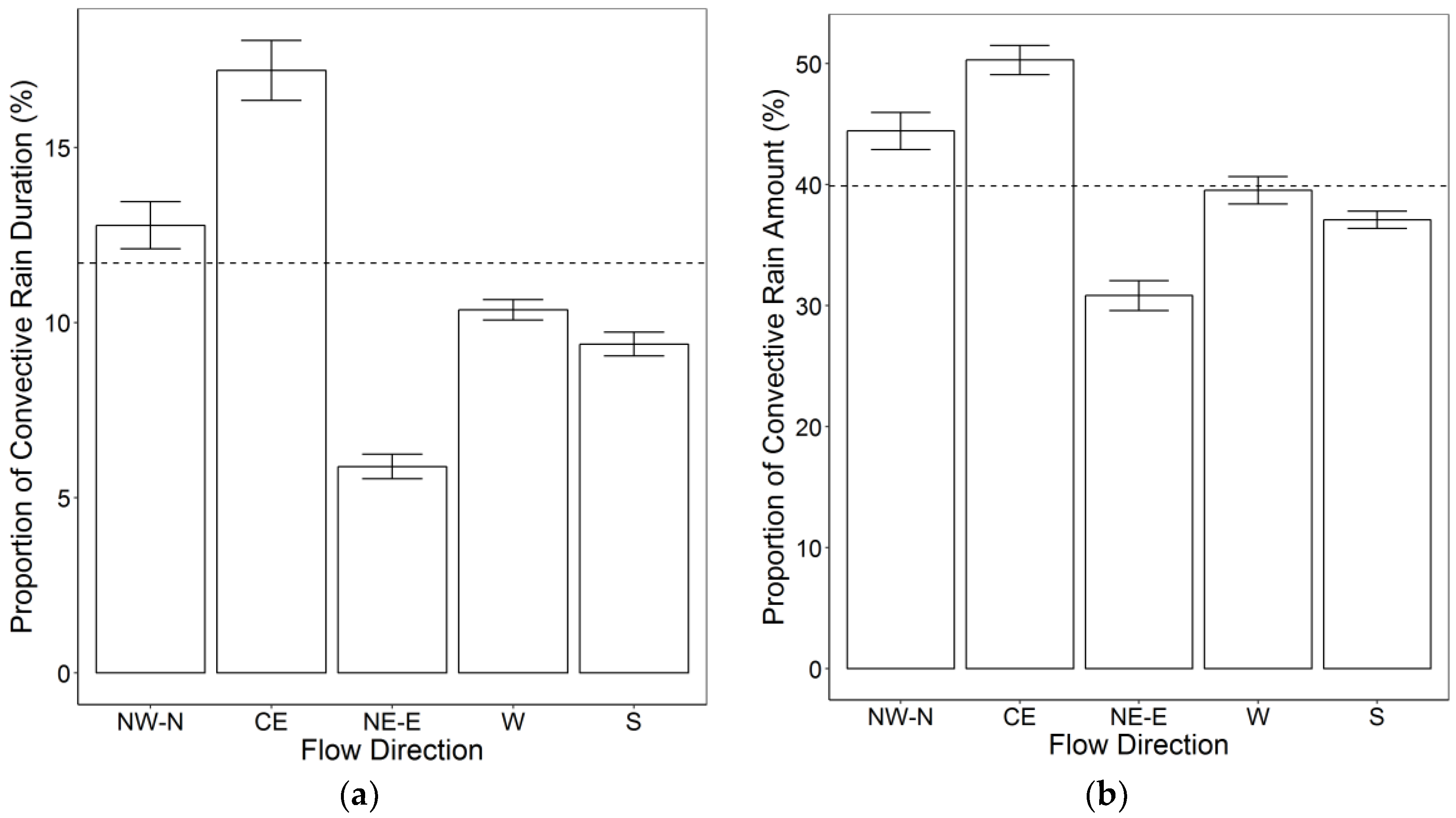
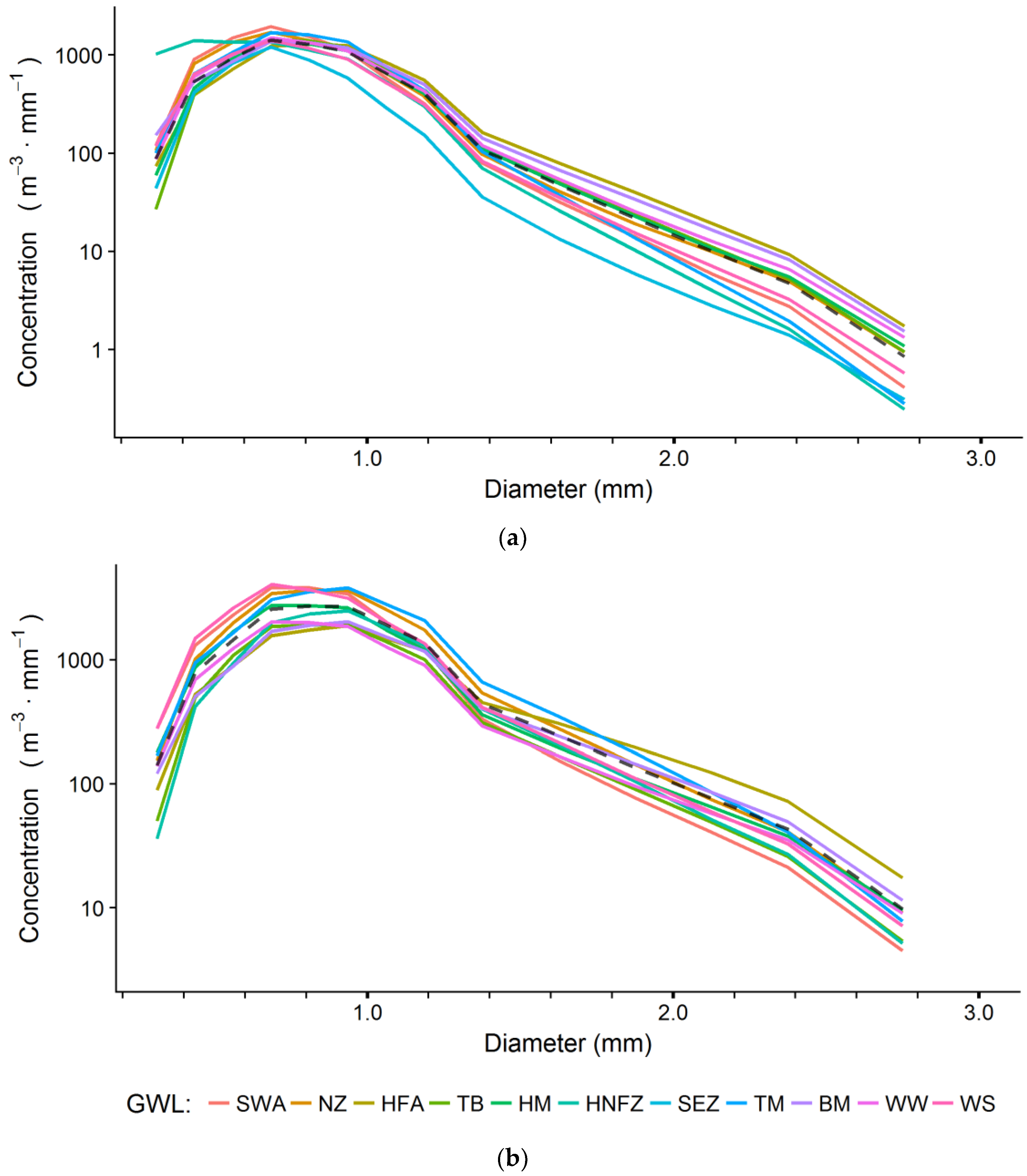
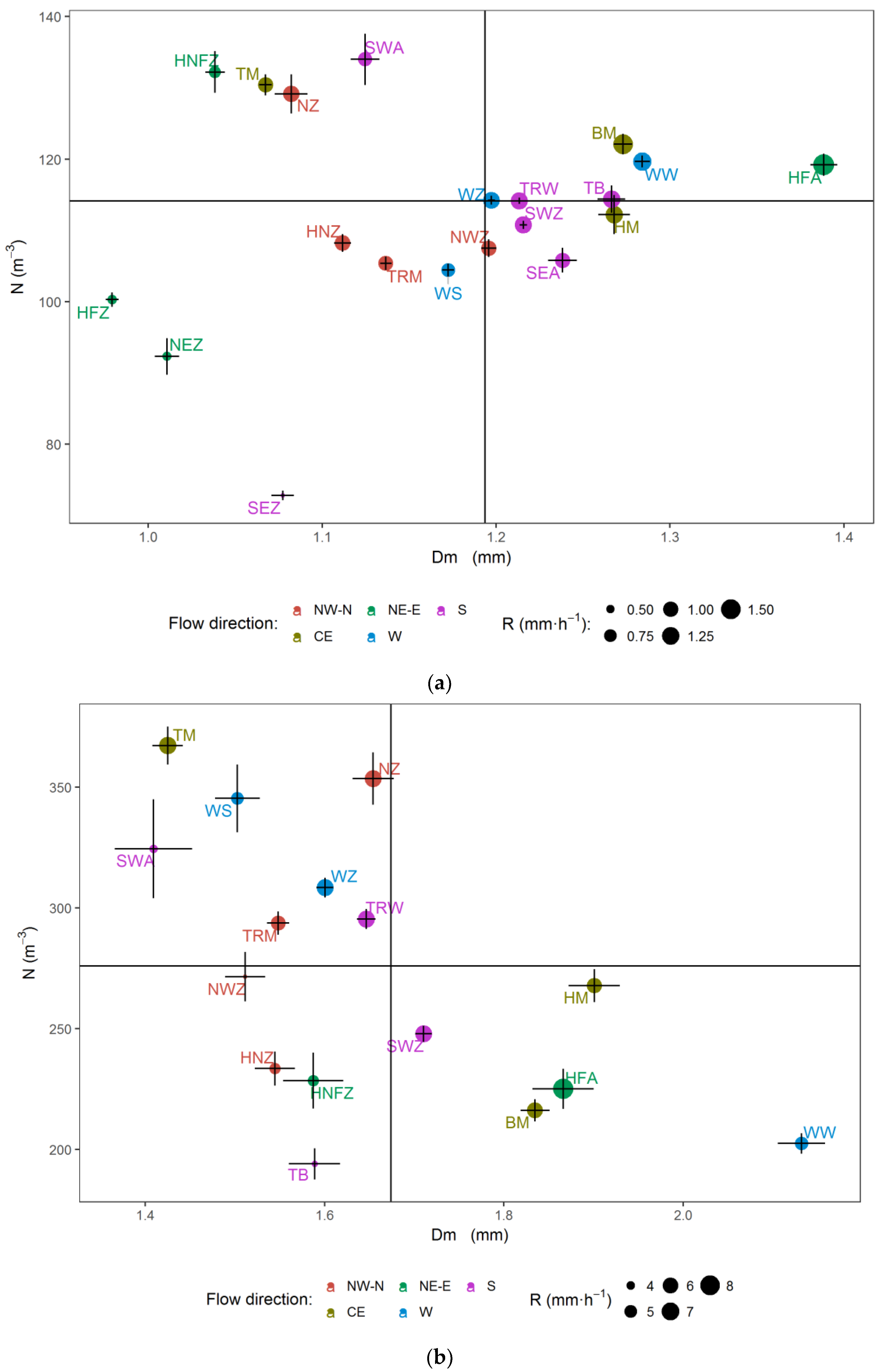
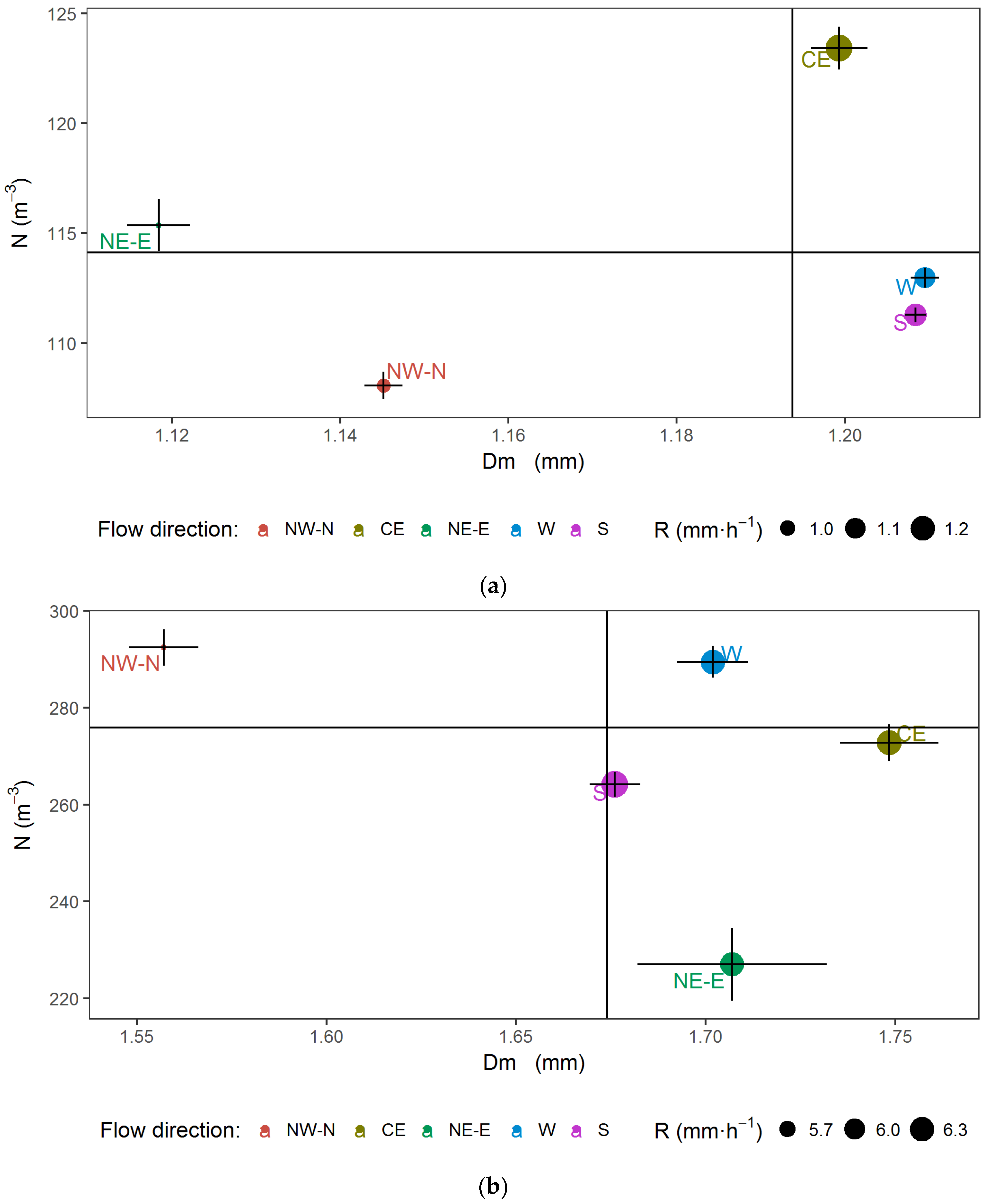


| Flow Direction | GWL | Accumulated Duration [min] | ||
|---|---|---|---|---|
| Convective | Stratiform | |||
| W: Westerly | WA | Anticyclonic Westerly | 2 | 441 |
| WZ | Cyclonic Westerly | 12,101 | 79,492 | |
| WS | South-Shifted Westerly | 1288 | 35,715 | |
| WW | Maritime Westerly | 3454 | 30,797 | |
| S: Southerly | SWA | Anticyclonic Southwesterly | 623 | 4404 |
| SA | Anticyclonic Southerly | 0 | 0 | |
| SEA | Anticyclonic Southeasterly | 9 | 4954 | |
| SWZ | Cyclonic Southwesterly | 15,129 | 83,369 | |
| SZ | Cyclonic Southerly | 5 | 296 | |
| TB | Low over the British Isles | 1001 | 7703 | |
| TRW | Trough over Western Europe | 8979 | 137,716 | |
| SEZ | Cyclonic Southeasterly | 37 | 11,670 | |
| NW–N: Northwesterly, Northerly | NWA | Anticyclonic Northwesterly | 0 | 121 |
| NA | Anticyclonic Northerly | 0 | 0 | |
| HNA | Icelandic High, Ridge C.E. * | 0 | 0 | |
| HB | High over the British Isles | 1 | 883 | |
| NWZ | Cyclonic Northwesterly | 1714 | 20,052 | |
| NZ | Cyclonic Northerly | 1507 | 4573 | |
| HNZ | Icelandic High, Trough C.E. | 1076 | 13,672 | |
| TRM | Trough over C.E. | 5967 | 32,031 | |
| CE: Main high/low pressure area over Central Europe (no specific prevailing direction) | HM | High over C.E. | 2673 | 6464 |
| TM | Low (Cut-Off) over C.E. | 2157 | 13,966 | |
| BM | Ridge across C.E. | 3358 | 18,977 | |
| NE–E: Northeasterly, Easterly | NEA | Anticyclonic Northeasterly | 0 | 977 |
| HFA | Scandinavian High, Ridge C.E. | 696 | 7734 | |
| HNFA | High Scandinavia-Iceland, Ridge C.E. | 0 | 0 | |
| NEZ | Cyclonic Northeasterly | 129 | 3711 | |
| HFZ | Scandinavian High, Trough C.E. | 0 | 6756 | |
| HNFZ | High Scandinavia-Iceland, Trough C.E. | 924 | 9361 | |
| - | U | Transitional | 0 | 0 |
| Whole Dataset | Stratiform Rain | Convective Rain | |
|---|---|---|---|
| Global model | 0.584 | 0.357 | 2.52 |
| GWL model | 0.55 | 0.345 | 2.3 |
© 2018 by the authors. Licensee MDPI, Basel, Switzerland. This article is an open access article distributed under the terms and conditions of the Creative Commons Attribution (CC BY) license (http://creativecommons.org/licenses/by/4.0/).
Share and Cite
Ghada, W.; Buras, A.; Lüpke, M.; Schunk, C.; Menzel, A. Rain Microstructure Parameters Vary with Large-Scale Weather Conditions in Lausanne, Switzerland. Remote Sens. 2018, 10, 811. https://doi.org/10.3390/rs10060811
Ghada W, Buras A, Lüpke M, Schunk C, Menzel A. Rain Microstructure Parameters Vary with Large-Scale Weather Conditions in Lausanne, Switzerland. Remote Sensing. 2018; 10(6):811. https://doi.org/10.3390/rs10060811
Chicago/Turabian StyleGhada, Wael, Allan Buras, Marvin Lüpke, Christian Schunk, and Annette Menzel. 2018. "Rain Microstructure Parameters Vary with Large-Scale Weather Conditions in Lausanne, Switzerland" Remote Sensing 10, no. 6: 811. https://doi.org/10.3390/rs10060811
APA StyleGhada, W., Buras, A., Lüpke, M., Schunk, C., & Menzel, A. (2018). Rain Microstructure Parameters Vary with Large-Scale Weather Conditions in Lausanne, Switzerland. Remote Sensing, 10(6), 811. https://doi.org/10.3390/rs10060811




